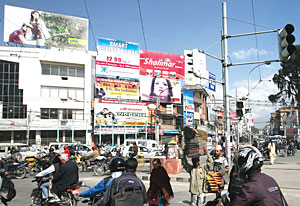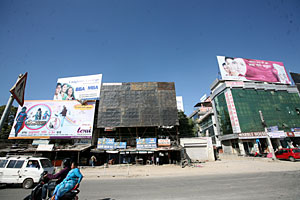 KIRAN PANDAY |
Many may complain that they are Kathmandu's biggest eyesores, but streetside billboards are now the mainstay of the country's advertising industry and a major source of income for the municipality.
Stacked on top of each other on rooftops, obliterating the facades of new buildings and spreading across intersections, billboards have now become the city's new skyline.
There are 35 companies specialising in printing signage, and the number of registered sites in the city core is now nearing 1,000.
 |
Despite their rapid spread, however, hoarding boards remain an unregulated business. A Supreme Court ruling in 2006 banned hoarding boards near temples and heritage sites, but there are no fixed criteria on the size, location, building materials or safety standards required to get a permit. Luckily no one was hurt when a storm blew down a giant hoarding board advertising a housing company last year, but it blocked the Ring Road for hours.
 |
"It is very possible for similar incidents to take place in the future, we haven't learnt our lesson," says Awadhesh Das of Ultimate Marketing, who has been advocating an insurance policy for hoarding boards. There are also examples of houses that have developed cracks because of the stress from scaffolds.
The municipality charges Rs 60 per square foot for hoarding boards, but has not been able to regulate their haphazard growth. The huge billboards outside Maitighar and Singha Darbar cost about Rs 1.4 million in rental to the advertiser. Outdoor billboards now make up a full 50 per cent of Nepal's total advertising market.
 |
 |
As with most other sectors of the economy, unhealthy competition among agencies dealing in billboards has led to the city's disfiguration. Rival companies have been seen to place their boards on top of each other.
"Placement is the key, that is why companies want their boards to be placed in areas with high traffic flows even if they are already overcrowded," Gorkhali says. Ultimately, this is counterproductive because with so many hoarding boards competing for attention from commuters stuck in traffic, the effectiveness of the message is diminished.
"Ten boards in one place does not make good business sense but every company wants to advertise in the same spot," says Balistha Shukla of Art Centre, the first company to start billboard installation in Nepal.
It's big money
The expanding size and spread of billboards in Kathmandu are indicative of the growth in the market.
Although there are no accurate figures, industry insiders estimate the market of hoarding boards to be a whooping
Rs 1.5 billion, half of the total advertising industry. "The figure is not big, if we take into account all outdoor advertising," Awadhesh Das of Ultimate Marketing says.
The municipality earned Rs 10.65 million by taxing advertisers last year. Ten per cent of the city's hoarding boards, however, have been evading taxes, and the municipality estimates a 25 per cent decrease in revenue this year after the ban on all liquor and tobacco billboards.
The biggest boards are in Thapathali, New Road, Maitighar and Singha Darbar, where advertisers are paying between
Rs 500,000 to Rs 1.4 million in rent every year.
Hoarding the boards
There are two types of companies working in hoarding boards. The first group have their own hoarding boards, flex printing facilities and in some cases, their own designers. They charge between Rs 300 to Rs 600 per square foot, including all charges, rental fees, and other taxes.
Others are advertising agencies that mediate with board owners, flex printers and authorities on behalf of the advertisers. They take about 15 per cent of the annual board rental. House owners are generally paid between Rs 50,000 to Rs 300,000 per year.
READ ALSO:
Back to work, EDITORIAL
Election hangover, DAMAKANT JAYSHI
Humla's no Siberia, ASHUTOSH TIWARI
Growing wellness, PAAVAN MATHEMA


